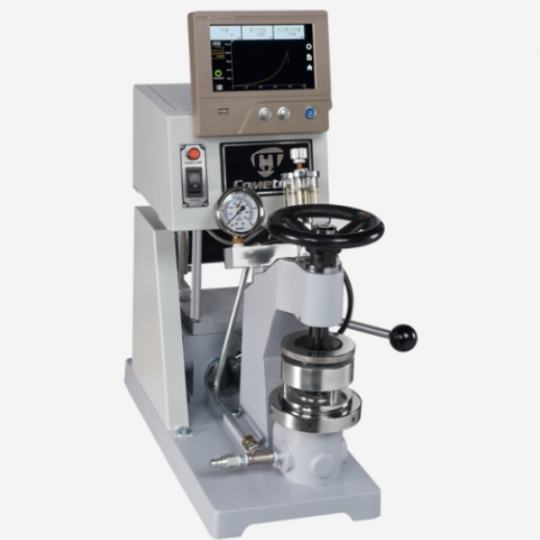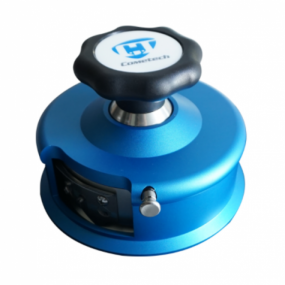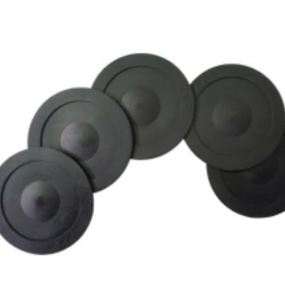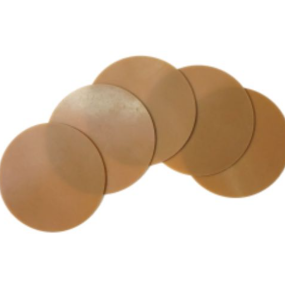QC-116 Digital Bursting Strength Tester
-
543
-
0765 259 545
Digital Bursting Strength Tester
Model: QC-116
Cometech - Taiwan
Digital Bursting Strength Tester is used for testing the bursting resistance for samples such as base paper, corrugating paper, leather, synthetic leather. This tester is a digital type that features automatic compensation mechanism and sensor calibration to obtain a more accurate test result. The real-time force graph shows current status in various units for user’s choice, facilitating user’s data reading.
*Metric/imperial unit.
*Graph: real-time pressure and bursting time.
*Compensation mechanism: automatic compensation in reference to aluminum foil.
*Equipped with a 7-inch touch screen.
*Pressure gauge: powered by a smart, precise electric sensor.
*Up to 50 test data can be saved.
*Data exportable to USB.
*Chinese, English and Japanese available.
Model: QC-116
Cometech - Taiwan
Digital Bursting Strength Tester is used for testing the bursting resistance for samples such as base paper, corrugating paper, leather, synthetic leather. This tester is a digital type that features automatic compensation mechanism and sensor calibration to obtain a more accurate test result. The real-time force graph shows current status in various units for user’s choice, facilitating user’s data reading.
*Metric/imperial unit.
*Graph: real-time pressure and bursting time.
*Compensation mechanism: automatic compensation in reference to aluminum foil.
*Equipped with a 7-inch touch screen.
*Pressure gauge: powered by a smart, precise electric sensor.
*Up to 50 test data can be saved.
*Data exportable to USB.
*Chinese, English and Japanese available.
Digital Bursting Strength Tester
Model: QC-116
Cometech - Taiwan
Conform to Standards
ASTM D2210
ISO 2759
GB/T 6545
JIS P8112
JIS L1018
TAPPI T403
Industry
Textile, Paper, Packaging
Specifications of QC-116
Type: High pressure/ Low pressure/ Textile
Test speed
High pressure:170 ± 15 ml/min
Low pressure:95 ± 5 ml/min
Textile:98 ± 4 ml/min
Pressure display: By digital touch screen
Capacity: 75 kg/c㎡
Platen diameter-Upper
High pressure:31.5 ± 0.05 mm
Low pressure:30.5 ± 0.05 mm
Textile:30.5 ± 0.05mm
Platen diameter-Lower
High pressure:31.5 ± 0.05 mm
Low pressure:33.1 ± 0.05 mm
Textile:30.5 ± 0.05mm
Gear position: Pressurization, neutral, return
Features
1. Using flow switch, and can switch to different speed of pressurization
2. Equipped with a 7-inch touch screen, and show real-time pressure and bursting time
3. Data exportable to USB
Dimension: 53 x 33 x 58 cm
Weight: 60 kg
Power: Single phase 110~240VAC,5A
Product Similar
Circular Sample Cutter
Model: QC-PS
Cometech - Taiwan
QC-PS circular sample Cutters can cut 100cm² sample, measure sample unit weight, the minimum readings of balance need to reach 0.01g. This cutter can cut circular sample thickness up 5mm.
Cutting samples include woven fabric, nowoven fabric, knitting fabric, carpet, plastic film, styrofoam, paper or wooden made thin plate, etc. It is indispensable instrument for clothing and fabric dyeing industries for gaining samples.
Industry: Textile, Plastic, Paper
0765 259 545
High pressure rubber membrane
Manufacturer: Cometech - Taiwan
Contact for quotation: 0765 259 545
This accessory used to test the durability of the platform is placed under the test piece. After creating pressure, glycerin will hold the rubber membrane and then break the test piece.
This is a test consumable, when used for a period of time, it will be dirty, tired or damaged and need to be replaced if necessary.
High pressure rubber membrane is applied in the range of 6 ~ 75kgf/cm
0765 259 545
Low Pressure Rubber Diaphragm
Cometech
The rubber diaphragm plays a vital role in the specimen bursting test setup. Located underneath the specimen pressure plate, it plays a vital role in applying pressure during the test.
When pressure is applied, the glycerin-filled diaphragm expands, eventually causing the specimen to burst. This is a test consumable that can become soiled, worn or damaged through accidental use. It may need to be replaced when necessary.
The low pressure rubber diaphragm is suitable for pressures from 0 to 10 kgf/cm2.




 SCITEK - China
SCITEK - China EBP - China
EBP - China SOOHOW - China
SOOHOW - China ZD Instrument - China
ZD Instrument - China Yante
Yante JJ-Test
JJ-Test Labthink
Labthink Hunterlab
Hunterlab EURPING - China
EURPING - China Wisdom - China
Wisdom - China ZYLAB - CHINA
ZYLAB - CHINA ERKAYA -
ERKAYA - Novotest - Ukraine
Novotest - Ukraine Moderner - China
Moderner - China GBPI - China
GBPI - China Milkotester - Bulgaria
Milkotester - Bulgaria LAMY RHEOLOGY
LAMY RHEOLOGY  Emco
Emco GESTER - China
GESTER - China GonDo - Taiwan
GonDo - Taiwan Agri-instrument - China
Agri-instrument - China CHN - China
CHN - China PNTOO - China
PNTOO - China TESTER SANGYO
TESTER SANGYO FRU - China
FRU - China Rucca - China
Rucca - China HSIANG TAI - CHINA
HSIANG TAI - CHINA FYI - China
FYI - China Boxun - China
Boxun - China Linshang - China
Linshang - China Hanon - China
Hanon - China PCE - UK
PCE - UK  Biuged
Biuged IRIS
IRIS ACEY - China
ACEY - China 3NH
3NH XS Instruments
XS Instruments Doser
Doser OPTIKA - ITALY
OPTIKA - ITALY Great Safe
Great Safe Kett
Kett Mitutoyo
Mitutoyo Cometech - Taiwan
Cometech - Taiwan Veego
Veego COPLEY SCIENTIFIC
COPLEY SCIENTIFIC  Exotek
Exotek Total Meter
Total Meter PNShar
PNShar Radwag
Radwag SH Scientific
SH Scientific X-Rite
X-Rite Metrotec
Metrotec Hach
Hach Hanna
Hanna Endecotts
Endecotts TRINAMIX
TRINAMIX HMKTEST
HMKTEST PackTest Machines Inc
PackTest Machines Inc CHAO QIANG - CHINA
CHAO QIANG - CHINA Sartorius - Germany
Sartorius - Germany SIKA - Germany
SIKA - Germany Ohaus
Ohaus SUN SCIENTIFIC
SUN SCIENTIFIC Aczet
Aczet Trace2o - UK
Trace2o - UK Glas -Col - USA
Glas -Col - USA Beijing
Beijing ATAGO – JAPAN
ATAGO – JAPAN TECHLAB SYSTEMS
TECHLAB SYSTEMS ESI
ESI RJS - USA
RJS - USA Kruss
Kruss Lumex Instruments
Lumex Instruments ELECTROLAB
ELECTROLAB  Haida
Haida Horiba
Horiba Konica
Konica Datacolor
Datacolor CRYSTE
CRYSTE Uni-T
Uni-T Oxford Instruments
Oxford Instruments Fuzhou Furi - China
Fuzhou Furi - China Alpha MOS
Alpha MOS  Drick
Drick FPInnovations - Canada
FPInnovations - Canada Memmert
Memmert 3M
3M Advantec
Advantec Newstar
Newstar ANTON PAAR
ANTON PAAR







